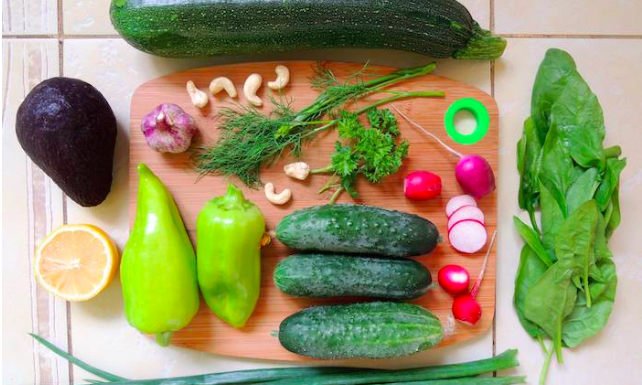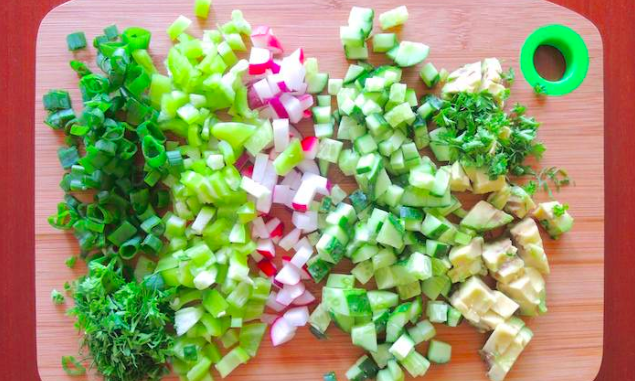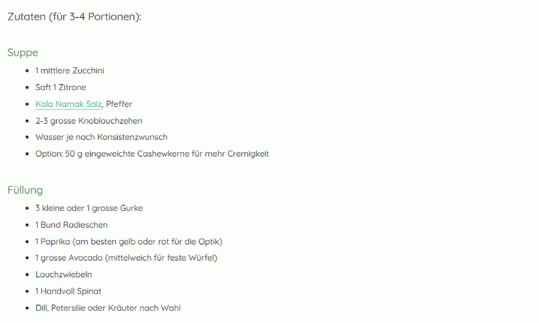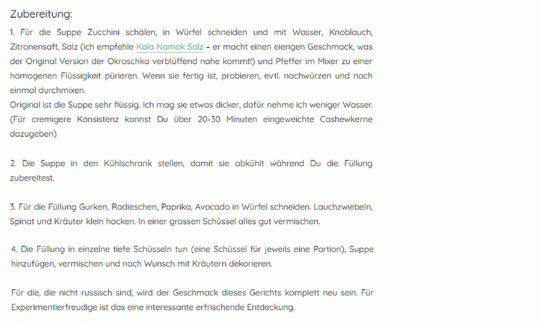Russian summer soup Okroshka with zucchini (raw-vegan)
raw-vegan
Ingredients (for servings, )
| For the soup | |
|---|---|
| 1 | Zucchini, raw, (organic?) (6.9 oz) |
| 1 | Lemons, raw (limes, organic?) (2.0 oz) |
| 2 cloves | Garlic (organic?) (0.21 oz) |
| 200 ml | Drinking water, raw (organic?) (7.0 oz) |
| 1 dash | Table salt (table salt, raw?, organic?) (0.01 oz) |
| 1 dash | Black pepper (organic?, raw?) (0.00 oz) |
| For the soup garnish | |
| 1 | Cucumbers, raw (organic?) (16 oz) |
| 1 Bund, gerüstet | Radishes, raw (organic?) (5.3 oz) |
| 1 | Sweet pepper, yellow, raw (organic?) (5.5 oz) |
| 1 | Avocados, raw (organic?) (7.1 oz) |
| 2 | Spring onions, stems and leaves only (raw, organic?) (1.7 oz) |
| 1 cup | Spinach, raw (vegetable spinach) (1.1 oz) |
| 1 sprigs | Parsley, fresh, raw (leaf parsley, parsley) (0.04 oz) |
| ¼ bunch | Dill, raw (herb, seeds, organic?) (0.22 oz) |
Equipment
- blender or food processor
- vegetable peeler
- refrigerator
- citrus juicer (lemon squeezer)
Type of preparation
- chop or grind
- food preparation without heating
- blend
- squeeze
- cool
- season to taste
- purée
- remove the skin
- peel
Preparation
For the soup
Peel the zucchini and cut into cubes. Squeeze the lemon and set the juice aside. Peel the garlic.In the original recipe, 50 g of soaked cashews (soak for about 20-30 minutes) are optionally used for 3-4 portions for more creaminess.
Puree the prepared ingredients with water, salt and pepper in a blender until you get a homogenous liquid. Season to taste if necessary and blend again.
The blogger recommends using Kala Namak salt, which gives the dish an egg flavor and is surprisingly close to the original version of okroshka.
The original soup is very liquid, but the blogger prefers it creamier. Decide for yourself how much water you want to use, as there are no instructions in the original recipe.
Place the soup in the refrigerator to cool while you prepare the filling.
For the soup garnish
Dice the cucumber, radishes, peppers and avocado. Finely chop the spring onions, spinach and herbs. Mix everything well in a large bowl.You can use other herbs besides parsley and dill. The original recipe does not specify the amount of herbs and spring onions.
In addition to an orange pepper, according to the blogger, a red pepper also goes well with it.
Arranging and Serving
Place the filling into individual deep bowls (one bowl for each serving). Add the soup, mix and decorate with herbs if desired.
|
Nutritional Information per person
Convert per 100g
|
2000 kcal | |
|---|---|---|
| Energy | 135 kcal | 6.7% |
| Fat/Lipids | 7.9 g | 11.3% |
| Saturated Fats | 1.2 g | 6.0% |
| Carbohydrates (inc.dietary fiber) | 17 g | 6.2% |
| Sugars | 5.1 g | 5.6% |
| Fiber | 6.3 g | 25.0% |
| Protein/Albumin | 3.6 g | 7.3% |
| Cooking Salt (Na:75.3 mg) | 191 mg | 8.0% |
| Essential micronutrients with the highest proportions | per person | 2000 kcal | |
|---|---|---|---|
| Vit | Vitamin C (ascorbic acid) | 108 mg | 135.0% |
| Vit | Vitamin K | 89 µg | 118.0% |
| Vit | Folate, as the active form of folic acid (née vitamin B9 and | 103 µg | 51.0% |
| Elem | Potassium, K | 811 mg | 41.0% |
| Vit | Vitamin B6 (pyridoxine) | 0.41 mg | 29.0% |
| Min | Copper, Cu | 0.26 mg | 26.0% |
| Min | Manganese, Mn | 0.46 mg | 23.0% |
| Vit | Pantothenic acid (vitamin B5) | 1.3 mg | 21.0% |
| Elem | Magnesium, Mg | 58 mg | 15.0% |
| Elem | Phosphorus, P | 102 mg | 15.0% |
Detailed Nutritional Information per Person for this Recipe
The majority of the nutritional information comes from the USDA (US Department of Agriculture). This means that the information for natural products is often incomplete or only given within broader categories, whereas in most cases products made from these have more complete information displayed.
If we take flaxseed, for example, the important essential amino acid ALA (omega-3) is only included in an overarching category whereas for flaxseed oil ALA is listed specifically. In time, we will be able to change this, but it will require a lot of work. An “i” appears behind ingredients that have been adjusted and an explanation appears when you hover over this symbol.
For Erb Muesli, the original calculations resulted in 48 % of the daily requirement of ALA — but with the correction, we see that the muesli actually covers >100 % of the necessary recommendation for the omega-3 fatty acid ALA. Our goal is to eventually be able to compare the nutritional value of our recipes with those that are used in conventional western lifestyles.
| Essential fatty acids | per person | 2000 kcal |
|---|---|---|
| Linoleic acid; LA; 18:2 omega-6 | 0.92 g | 9.0% |
| Alpha-Linolenic acid; ALA; 18:3 omega-3 | 0.12 g | 6.0% |
| Essential amino acids | per person | 2000 kcal |
|---|---|---|
| Tryptophan (Trp, W) | 0.04 g | 15.0% |
| Threonine (Thr, T) | 0.11 g | 12.0% |
| Isoleucine (Ile, I) | 0.13 g | 10.0% |
| Lysine (Lys, K) | 0.18 g | 10.0% |
| Valine (Val, V) | 0.15 g | 10.0% |
| Leucine (Leu, L) | 0.20 g | 8.0% |
| Phenylalanine (Phe, F) | 0.13 g | 8.0% |
| Methionine (Met, M) | 0.05 g | 5.0% |
| Vitamins | per person | 2000 kcal |
|---|---|---|
| Vitamin C (ascorbic acid) | 108 mg | 135.0% |
| Vitamin K | 89 µg | 118.0% |
| Folate, as the active form of folic acid (née vitamin B9 and | 103 µg | 51.0% |
| Vitamin B6 (pyridoxine) | 0.41 mg | 29.0% |
| Pantothenic acid (vitamin B5) | 1.3 mg | 21.0% |
| Riboflavin (vitamin B2) | 0.20 mg | 14.0% |
| Thiamine (vitamin B1) | 0.12 mg | 11.0% |
| Niacin (née vitamin B3) | 1.8 mg | 11.0% |
| Vitamin A, as RAE | 85 µg | 11.0% |
| Vitamin E, as a-TEs | 1.3 mg | 11.0% |
| Biotin (ex vitamin B7, H) | 0.62 µg | 1.0% |
| Essential macroelements (macronutrients) | per person | 2000 kcal |
|---|---|---|
| Potassium, K | 811 mg | 41.0% |
| Magnesium, Mg | 58 mg | 15.0% |
| Phosphorus, P | 102 mg | 15.0% |
| Calcium, Ca | 71 mg | 9.0% |
| Sodium, Na | 75 mg | 9.0% |
| Essential trace elements (micronutrients) | per person | 2000 kcal |
|---|---|---|
| Copper, Cu | 0.26 mg | 26.0% |
| Manganese, Mn | 0.46 mg | 23.0% |
| Iron, Fe | 1.6 mg | 11.0% |
| Zinc, Zn | 0.99 mg | 10.0% |
| Selenium, Se | 1.4 µg | 3.0% |
| Fluorine, F | 44 µg | 1.0% |
| Iod, I (Jod, J) | 1.1 µg | 1.0% |
This okroshka is a raw vegan version of the Russian soup with zucchini, cucumber, peppers, radishes and herbs.
Okroshka is a Russian national dish. The cold soup in its original version contains non-vegan ingredients such as sour cream (or buttermilk or kefir), sausage and egg.
Serving size: The original dish is designed for 3-4 people. Depending on the amount used, it is suitable as a starter or main course, although the latter has very few calories.
Nutrient profile: According to GDA guidelines, one portion of this recipe covers 120-130% of the average daily requirement of vitamin C and over 100% of that of vitamin K. Folic acid is covered by 50%. The ratio between linoleic acid (LA) and alpha-linolenic acid (ALA) is 8:1, which is above the recommended maximum ratio of 5:1, but the absolute amounts are so small that they can be ignored. With just 133 kcal per portion, this dish is very low in calories.
Zucchini: Zucchini is easy to digest, low in calories and rich in vitamins. Be careful with bitter-tasting zucchini. The bitter taste is caused by the poisonous bitter substances cucurbitacins. These cannot be destroyed by cooking and attack the stomach and intestinal mucosa. An increased content of bitter substances can arise, especially when grown at home (by backcrossing home-grown seeds or crossing with other pumpkin plants).
Cucumbers: The cucumber ( Cucumis sativus) belongs to the gourd family. Depending on the use, we now differentiate between the cucumbers used in this recipe and the pickled or seasoned cucumbers. The cucumber is a low-calorie but very refreshing vegetable due to its high water content (over 90-96%). While in many European countries the use of the cucumber corresponds to its name, in East and South Asia it is often cooked as a vegetable side dish.
Radishes: The typical taste of radishes is caused by a mustard oil that is produced when the plant is injured (by handling or biting) from the mustard oil glycosides contained in the plant.
Avocado: The highly nutritious flesh of the raw fruit is greenish-yellow to golden yellow, soft and has a creamy consistency. The avocado has a high fat content and is rich in unsaturated fatty acids and potassium.
Spinach: Spinach is rich in vitamins (especially vitamin K, folic acid, vitamins A and C), protein and minerals. Despite the high oxalic acid content, consuming raw spinach in reasonable amounts is not harmful to health.
Recommended consumption of spinach: Spinach should not be stored at room temperature for long periods (around a week). Spinach contains a lot of nitrate, which bacteria convert into harmful nitrite. This can cause problems, especially in children, as it impairs the transport of oxygen in the body and the effects depend on both the amount consumed and body weight.
Kala Namak for egg flavor: The blogger recommends using Kala Namak instead of regular salt. Kala Namak, also known as black salt, is an artificially produced salt. Sulfates give it a characteristic sulfurous smell that is reminiscent of hard-boiled eggs. Many people find this smell repulsive. It has a brownish pink color when whole, and when ground it is violet to pink.
For more creaminess, you can use 50 g of soaked cashews for 3-4 servings. However, this means that this dish is not strictly speaking raw food and the fatty acid composition deteriorates.











